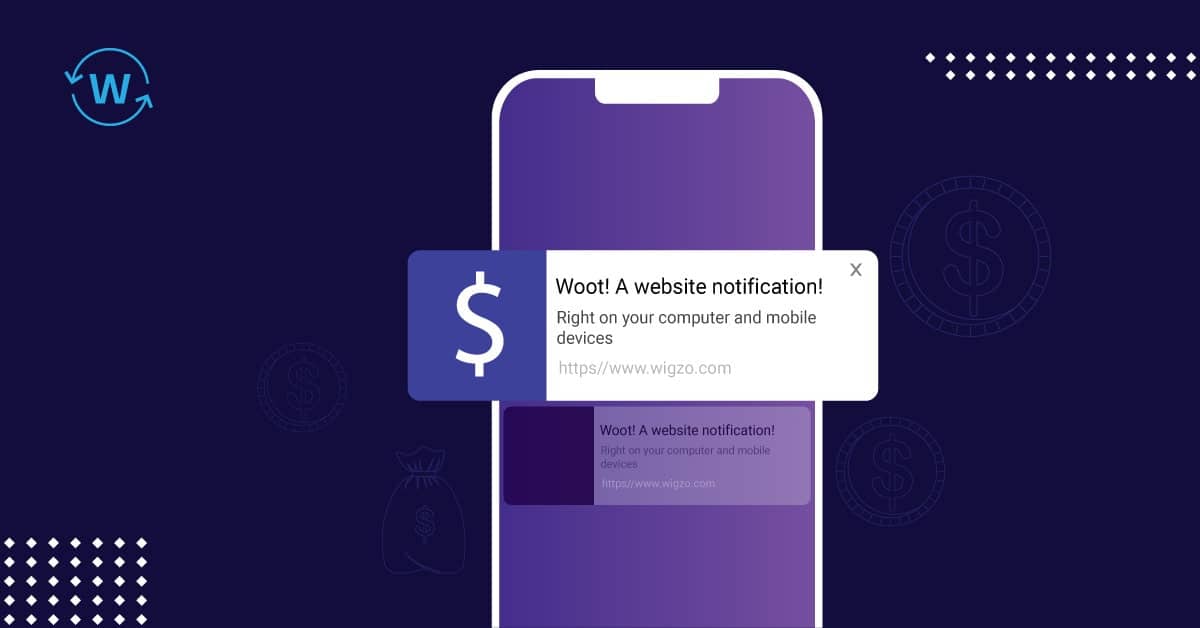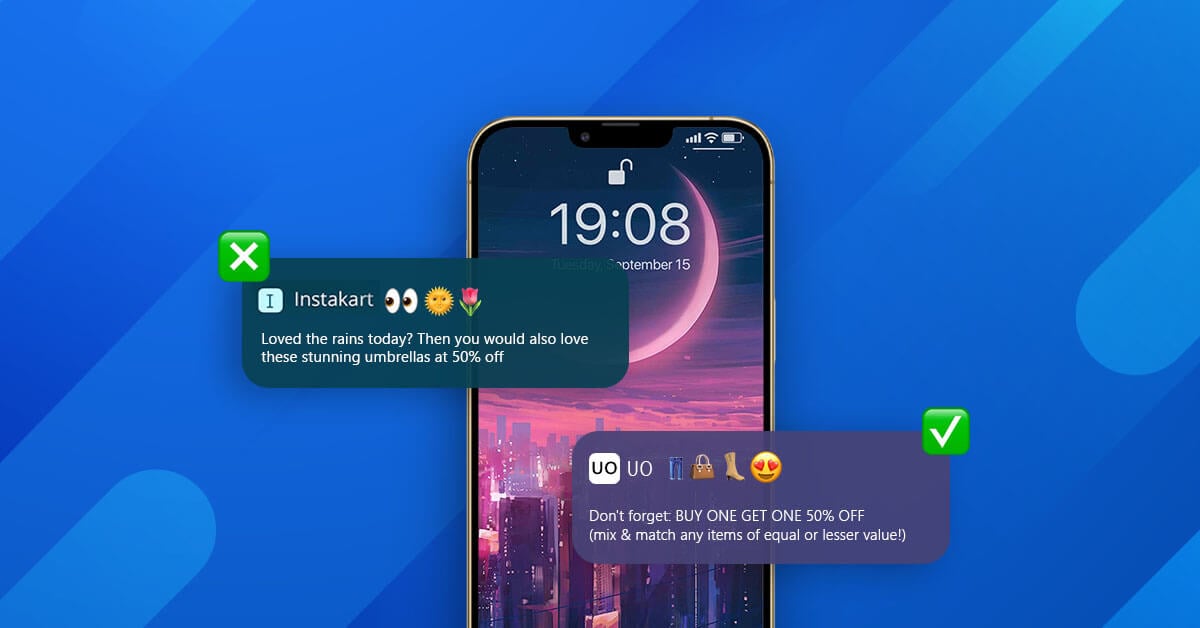As the mobile industry continues to grow, business owners, app developers and marketers are constantly on the lookout for ways and means to stand out from their competition. Be it following the latest marketing tactic or simply creating one based on their user statistics, businesses are going the extra length to last in the current market. But the one thing that we suggest most businesses settle for are push notifications.
Push notifications basically enable you to notify the user of a new message or event even when he is not using your app or visiting your website. They don’t just serve as an opportunity to promote something, but also engage with the users actively to reduce churn rates.
A study by Localytics shows that users launched an app or visited a website on an average 14.7 times per month when they accepted push notifications. Those who did not were at a mere average of 5.4 times. It was also observed that users who accepted push notifications engaged 3 times more than those who didn’t.
Push notifications today play an integral part in engagement and customer retention. Contrary to text notifications, they offer a wide range of customization and personalization offers.
When should businesses use push notifications?
In an age where personalization and context is of prime importance to acquire or retain customers, the power of push depends entirely on the business’s objectives and target audience. For users, a push notification is to serve the purpose of getting instant information regarding something they are or possibly could be interested in.
Here are a few things businesses can use push notifications for:
- Boost customer engagement levels and hence, retention rates
- Remain in the eyes of the customer on a regular basis
- Share news, deals, and promotions instantly
- Automate engagement and other internal processes
How do you implement push notifications?
While developers are responsible for creating an interface for businesses to send push notifications, companies like Wigzo provide a far more robust technology for the same. It enables you to target the right person in your audience with the right message, at the right time – instead of the conventional bombarding notifications that are a part of generalized campaigns.
Most studies and data show that personalized push notifications perform 4 times better than the generalized ones.
How do push notifications appear to the target audience and users?

Push notifications are the simplest and the most non-intrusive way to notify the target audience of something.
On a typical browser on the desktop, the notification would either appear at the top or bottom right of the screen. This ensures that the person does see the notification, but does not get irritated by its timed presence or feel that it is interrupting with what he is currently doing.
On mobile though – both iOS and Android, the notifications appear at the top of the screen in the banner when the device is in use. When not in use, the notifications appear on the locked screen and can be accessed by swiping downwards or sideways – based on the device being used.
iOS offers the user more options when it comes to notifications – from sound to the type of notification (banner, alert, badge icon), the user can literally opt for what he prefers.
In simpler words, push notifications to enable businesses to create and execute highly personalized campaigns for their target audience – all without interrupting or compromising on their overall experience.
How can you effectively use push notifications?
The key to running successful push notification campaigns is to determine how often and what needs to be pushed to your audience. It is important that businesses ensure that each of the notifications they strategize to send out, add value to the end-user.
While push notifications are mostly non-intrusive in nature, overdoing it might result in seeming like spam. But under-doing it might result in missing an opportunity to connect with your audience and not reaching your set objectives.
Before implementing push notifications, understand what your audience is looking for, their usage behavior, and what they expect from your business. This will ensure you avoid the most common mistakes.
For instance, Wigzo uses machine learning tools to track user behavior and understand your content to create global profiles that enable personalization to a whole new level.
What are the notification metrics that businesses need to measure?
Like every other effort made by a business to market themselves better, acquire customers, and retain them, push notifications should also be measured. While most marketers analyze the number, frequency, and rate at which they are disabled, here are a few metrics that actually need to be kept track of:
1. Number of notifications delivered
Instead of the frequency of notifications you push out, it is important to know how many of them are actually getting delivered. Push notifications might not really get delivered to your target audience because of various reasons – network or simply because they have been disabled.
Tracking this number will let you know just how many of your customers or target audience are active. This data can then be further segregated to identify those who should be approached via other means of communication.
2. Open rate and click-through rate
Since every notification is sent out with the goal of getting a visitor or user to complete a certain action, these metrics are important. Analyzing these numbers will let you know just how many people are actually interested in what the notification offered them and how many are simply ignoring it.
The open and click-through rates enable you to test, analyze and identify what your customers are more likely to engage with – what kind of message works the best, which day or time suits them the most, etc.
3. Interaction via push notifications
Continuing on the point above, tracking interaction is extremely important for businesses. This number will not just help you understand who your most active customers are, but will also help you identify the peak hours for engagement and the relevance of the notifications you sent to him.
This helps in the identification of the kind of messages/notifications that stimulate the person notified to take some sort of action. It is also important here to set specific goals for your notifications as well as test out different actions to understand which one is the most easily taken by the customer.
4. Engagement time after notification
It is important to measure the results of every notification sent out, closely. The one number that matters a lot is the engagement time after a notification is pushed out.
How long did the user stay on the app after a notification? How long did he browse your website after being notified of something? This number helps understand the relevance of what you’re offering to the customer and the engagement that can be expected from the ones you push out in the future.
5. Number of conversions
Ideally, a push notification is supposed to aid to an end goal of a business. Be it a sale, an update or an upgrade, the number of conversions need to be measured closely – micro and macro. This will help businesses and marketers understand the effectiveness of their campaigns as well as optimize them further for better results.
6. Delivery time
The delivery time of push notification can have a direct impact on engagement rates. Some studies have also observed the influence to be as high as 200%. Hence, marketers should experiment with different times, analyze their performance, and identify the slot that suits their business the best.
Push notifications offer a plethora of opportunities to businesses and marketers to communicate better with their existing as well as potential customers/users. But to make smart decisions, it is important to have smart analytics in place.
For every campaign that you execute using push notifications, your success metrics should be defined by the objectives. Look into every aspect of what an ideal effective campaign would result in it.
How Brands are using Push Notifications
Push notifications represent a unique way to communicate with the audience. Below eCommerce brands are using Push notifications for higher customer engagement and retention. Let’s dig deeper into it:
Awok
Awok wanted to capture a wider audience coming through Desktop and Mobile. They adopted push notifications and personalized user experience.
They opted for Push Notifications, one-click opt-in for visitors, and personalize their campaigns on a 1:1 basis.

Outcome
Awok improved its customer engagement rates and on-site conversions using push notifications. It delivered exceptionally scalable results in a span of 3 weeks.
They got a 43% increase in Opt-ins, 16% Average CTR on triggered campaigns (Browser Abandonment, Cart Abandonment, and Personalized Push campaigns) and 10% of overall revenue from the web and mobile sales via push notifications.
Golden Scent
Golden Scent is well-known among consumers in UAE for the variety of scents they offer at great deals.
They were facing a challenge in engaging their customers to improve retention.
Many of their store visitors didn’t want to share their email addresses, then they used the Push notifications one-click web push notifications.
Outcome
The store visitors could still avail of the discount and remain up-to-date with what’s new at the store, without sharing his email address or any kind of contact information.
With a higher opt-in rate than emails, web push notifications have recovered more than 15% of their abandoned carts.
They can also easily promote their popular deals and products to customers based on their demographics and previous purchase/interest data captured.
JetBlue
JetBlue, a global, award-winning travel company, was looking for a channel that can remind its customers when to check-in.
With Push Notifications adoption, now when there passengers check-in, they get nice reminders exactly 1 day before the flight is scheduled to depart. Push Notification has also availed In-flight status updates for customers that select this option.

Outcome
JetBlue improved the flying experience of customers by offers high value, practical content.
JetBlue’s efforts emphasized flyers to think nice about the brand, making them consider the airline the next time they go to book a flight.
In a study on push notifications, opt-in rates were highest in the travel and transportation niche (78%). People really appreciate being reminded of the key details that will improve their journey when they’re traveling.
Netflix
Netflix has a vast sea of user data available, the company can craft highly personalized push messages that draw on each customer’s viewing history.
As they’ve found, sending a simple reminder about a series that someone has been watching is an excellent way to improve engagement.

Outcome
It has been observed, Netflix sends mobile messages known as push notifications that may include information about newly-added TV shows and movies, personalized suggestions, or other notices.
The more data you have on the ways in which people interact with your brand (particularly their purchasing history), the more you can tailor your push messages to resonate with them.
Final Thoughts
Push notifications are an excellent channel for sending value to your customers, enhancing brand loyalty, and driving sales. Personalizing your messages based on user data keeps your content relevant and your customers engaged.
If you are also looking for a platform that offers amazing outcomes and can boost your conversion rate and revenue, then start your FREE trial with Wigzo today to experience intelligent marketing automation and personalization powered by machine learning.















